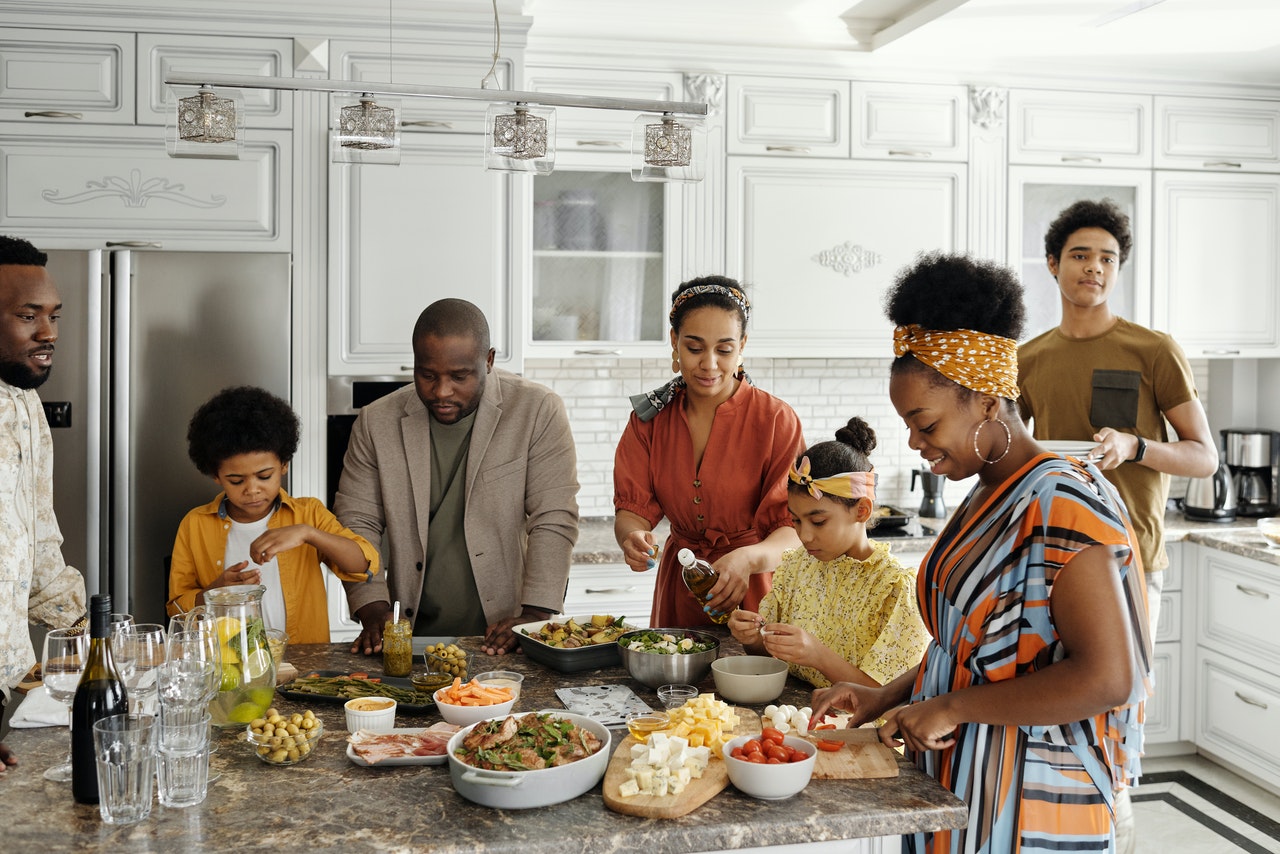The COVID-19 pandemic has impacted how many families see themselves and the world around them. Whether it’s due to job losses, the closing of schools, or concerns about an aging loved one’s health and well-being, more families are considering living in multigenerational households. While this living arrangement might not work for everyone, it does have its own set of unique benefits. The pandemic has undoubtedly changed our lives, but it’s also impacting many families’ thoughts about how they live together. Read on to learn more about multigenerational homes and whether this is something that could work for you and your family.
What is a multigenerational home?
A multigenerational home consists of at least two generations of family living together. Whether it’s an older adult child and their parents or a married couple and their young children and grandparents, the term essentially means that more than one generation lives together under the same roof. Living together with other family members certainly has its challenges, but some people see the benefit in this setup. There is a lot to consider before determining whether living in a multigenerational home is right for you. Let’s take a closer look at the pros and cons as well as key considerations before you decide to take the leap.
When and why is a Multigenerational home right for you or not?
It’s essential to weigh the pros and cons of living in a multigenerational house before you commit.
Pros and cons of living with your family. People in different age groups will have different lifestyles and different needs. Living under the same roof can cause conflict about schedules, sharing bathrooms, and mealtimes. However, a pro of living in a multigenerational home is that you’ll get to bond and spend more quality time together. It really comes down to what your priorities in life are and what your current lifestyle demands.
Challenges of living with extended family. Living with a large family can be challenging in many ways. Whether it’s a lack of privacy, space, or free time, having many people together under one roof can feel constricting for some people. If you’re living with an elderly family member, responsibilities about who will be the caregiver can cause issues. The same applies if there are infants or young children in the house.
Benefits of living with your family. When you live under the same roof, you have an opportunity to strengthen family relationships. As a child of older parents, you’ll be able to keep close watch over them and make sure that their needs are being met. It’s also an excellent way for your children to spend quality time with their grandparents in their golden years.
How to find a multigenerational home: What to consider

You can choose to undergo a complete house remodel, or you might decide to purchase a new, larger home to accommodate your growing family. Here are some key things to consider when you’re looking for a multigenerational home.
Shared Spaces and Family Rooms. Will your living room be large enough to accommodate the entire family? Look for a home with a roomy shared space where everyone can spend time together comfortably.
Basements. A basement can double as an extra bedroom, a workout space, or a laundry room. Consider homes with a basement to give you more usable square footage.
Kitchen. The kitchen will need to be large enough for everyone to use without feeling cramped. You can also find homes that include two full kitchens, such as a duplex where each generation will have their own separate cooking space.
Bathrooms for kids. Make sure your home has enough bathrooms for everyone to use without conflict. A separate bathroom for the kids is ideal, especially if they need to get ready for school in the morning.
Bedrooms for kids. It’s essential that the home has ample bedrooms for all family members. If you have two kids, consider having them share a bedroom with a bunk bed unless you have enough bedrooms for everyone to have their own.
TV rooms. The living room or family room can work well as a TV room, but you can also place another TV in the basement so that some family members can watch what they want without being disturbed.
Private Spaces. Set up a separate space in the home where family members can get some privacy. Whether it’s a room over the garage or a reading nook, this is important to help keep the peace.
Home office. If a family member works from home, they should have their own private office space to work undisturbed.
Bedrooms for adults. A two-story or split-level home is ideal for multigenerational homes with adults. You can give the parents the master bedroom, while young adults can have the remaining bedroom(s) on a separate floor.
Bathrooms for adults. Having enough bathrooms can be challenging, so make sure your new home either has a full bath for each adult or, at minimum, a half-bath where they can have privacy and share the full bath for showers and bathing.
Accessibility. Consider the unique needs of elderly family members and determine if you’ll need to build a wheelchair ramp or add other vital features to ensure safety and improve accessibility for the elders in the family.
“Relaxing Spaces.” If you have the extra room, designate a quiet part of the home for reading, meditating, and generally relaxing.
Outdoor spaces. Make sure your yard is large enough so the kids have an outdoor place to play. If you have pets, this is also an important thing to consider.
Swimming pools. A pool isn’t necessary, but it can be an excellent distraction for the kids during the summer when school is out.
Garages. If you have several cars, consider a home with a garage that can accommodate all of them. Garages also make great workshops and provide extra storage for tools and other large items.
Decks. A deck is an attractive option for multigenerational homes. You can use it to barbecue, sunbathe, or just to give family members a nice place to relax outdoors.
Greenhouses. If you have a green thumb, consider adding a greenhouse to your backyard where you can grow your favorite veggies and other plants.
How to set up the home for privacy
Even if you love spending time together, having a private space is important. Here are some tips to help you set up a lovely private room for family members to enjoy.
Décor. Hang peaceful artwork on the walls and keep the colors soft and neutral in the room. Use simple pieces like a comfy loveseat, rocking chair, or a reclining sofa along with a large coffee table.
Light. The lighting should be soft in the private room. Add a floor lamp or table lamp so family members can sit down in quiet and read a book, meditate, or talk on the phone.
Rebuild. You may want to adapt an existing room to make it a private space. Consider adding a wall to make a large room smaller and break it up into separate rooms, or consider adding an Accessory Dwelling Unit (ADU).
Reuse. Feel free to reuse existing furniture or to reuse spaces you already have in your home. For example, if you have a room you’re currently using for storage, make this your new private room.
Remodels. If you’re doing a major remodel, consider whether you want to do it DIY or hire a pro. If the remodel is simple and just a matter of flooring or paint, you can probably do it yourself. However, it’s best to leave it to the professionals if it involves knocking down or adding a wall, or expanding the home.
This article shares interesting tips on how to communicate with your loved ones so you are able to have stronger bonds.
Benefits of living in a multigenerational home

While living in a multigenerational home certainly has some challenges, there are also many wonderful benefits.
Financial expenses. Sharing a home with other family members means that you’ll share in costs like utilities, mortgage, and other monthly expenses.
Homeowner responsibilities. With more people living in the home, you can assign different duties to each family member, such as mowing the lawn, doing the dishes, or cleaning the bathrooms.
Build and strengthen relationships. Living together can help you bond with your loved ones. It offers an incredible opportunity to strengthen relationships between your parents, your children, and other members of the family.
Safety. If you have elderly family members living with you, they’ll be safer than if they were on their own. The younger generations can also be a great help to the elders by running errands and simply monitoring them in case of an emergency.
Family activities. Improve bonding by taking part in some fun family activities. Whether it’s growing a family garden, arranging a family game night, or just watching your favorite TV shows together, be sure to set aside some of your schedule for family activity time.
Insurance changes. Make sure you contact your homeowner’s insurance provider to update them about the new change. You may need to extend coverage to protect the belongings of your other family members, or if you’re building an addition or adding outdoor structures, you will need to raise your coverage limits.
Teaching younger generations. Living in a multigenerational home is an excellent way for younger family members to learn skills from the older generations. From learning how to cook from scratch to working with power tools, this is an excellent opportunity to help your children, including gen Z, thrive and grow through learning.
How to make it work
Here are some more tips when considering if a multigenerational setup is right for you.
Assign each family member a specific chore so that everyone plays a role in maintaining the household.
Make sure you have ample room, including bathrooms and bedrooms, before you make the change.
Talk to your real estate agent about the possibility of upgrading to a multigenerational home so they can help you find the right place.
Discuss the idea with your children beforehand so that they understand the new change and aren’t taken by surprise.
Talk to other family members about expectations, including sharing expenses and household duties in advance, so everyone understands their role.
Create private spaces including the backyard, garage, basement, or a separate room so that everyone has enough space to stretch out and enjoy some privacy.
Whether it’s the COVID pandemic itself or the economic impact, there are many reasons why this living arrangement might be right for you. Caring for your elderly parents or sharing the responsibilities of caring for younger kids can be easier when you’re all under the same roof. Remember that while living in a multigenerational household has its challenges, it’s also a fantastic way to strengthen family relationships that will last a lifetime.




